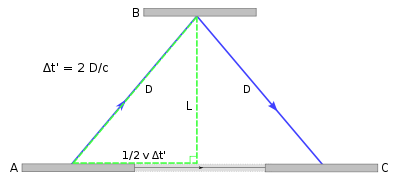Are space and time different things ?
How many dimensions are there?
$x$, $y$, and $z$ right?
How sure are you?
Is time a dimension?
Now when you think about it there is no way to conceptualize a four-dimensional object.
That should be it then, no fourth dimension, right? But what of the fact that you literally are further in time than when you started reading this. You’ve effectively moved forward in time.
So is time a dimension? Time is defined as, and I quote “The indefinite continued progress of existence and events in the past, present, and future regarded as a whole”
Here’s the thing. There’s a very interesting phenomenon called time dilation. The most interesting example of this is a thought experiment known as thetwin paradox. But more on that later; lets try to understand first how motion can affect time.
It sounds crazy right?
The idea behind time dilation is a little complex. But it is central to time as well as space as I will soon prove to you.
If the video above confused you, don’t worry, We’ll get a little technical and prove it mathematically.
Here’s another way to look at it. Say you and a friend are standing next to each other.
Your friend is standing and holding a laser upwards towards a mirror hanging above. Don’t think about how the mirror is floating but just know that it is constantly floating above your friend.You’re both trying to measure how much time [in seconds] it will take for the light to hit the mirror and then come back.
So you’re both standing still with your clocks. He shoots the laser up, it bounces off the mirror and comes back.
So for the example in the picture you’re seeing essentially would be the distance L divided by the speed of light [c]. For the sake of simplicity let’s take that value to be 10 seconds. So it takes 10 seconds for the light to bounce off of the mirror and come back. Now when you’re both not moving you will see the light take the same amount of time.
Now let’s say the other person started moving. You’re still standing still, yet now when you measure your times, you measure the time for the light to go up and then back down to be 10.4 seconds as opposed to the 10 seconds before. Your friend tells you that his clock measured 10 seconds just like before.
“That’s strange. The distance between the other person and the mirror hasn’t changed, so why would the time increase?”
Think back to the video you watched before, and then look at the picture below. Imagine the person starts moving at point A, when the laser is fired. The light is now taking the blue path. It’s no longer taking the path of the picture above because now the person is moving. The distance the light has to travel is now longer because the light is traveling diagonally. Similar to the previous example, when neither of you were moving the light traveled length L and back. (2L) would be less than (2D/c)

So if you measured 10.4 seconds… what does that mean? Well, if you measured 10.4, and he measured 10 seconds, then it would seem that time was moving faster for him than it was for you. This unusual phenomenon is called time dilation. Your time was 10.4… why is it that number specifically do you think? In fact, how would you know how much slower it would be? It turns out there is a way to calculate this.
$$t’=\frac{t}{\sqrt{1-v^2/c^2}} $$
The time that you (the non-moving observer) measure, is denoted by t’. The way you would set the equation up for this specific example would be replacing t’ with 10.4 and t (the time measured by your friend) with 10. The other values you can tell based on the picture.
So how does this happen in everyday life? I don’t think i’ve ever had a different time while i was driving in my car then my friends waiting for me somewhere else. Well, here’s why, the difference is so incredibly small that it doesn’t actually create a problem. Think back to the Twin Paradox I told you about earlier, the idea is that if this principal is taken to the extreme, two twins could end up meeting each other at very different ages after one of the twins gets on a space ship and orbits around the earth.
It’s all probably still a little crazy to wrap your head around the idea of time moving at different rates based on how fast your moving, believe me it’s weird. Here is another video that should help out with how physicists think about this.
So what we’ve essentially unraveled here is how to travel in time! Not to the past (unfortunately), but to the future! In fact, you just did it when between now and when you started reading this sentence. trippy.